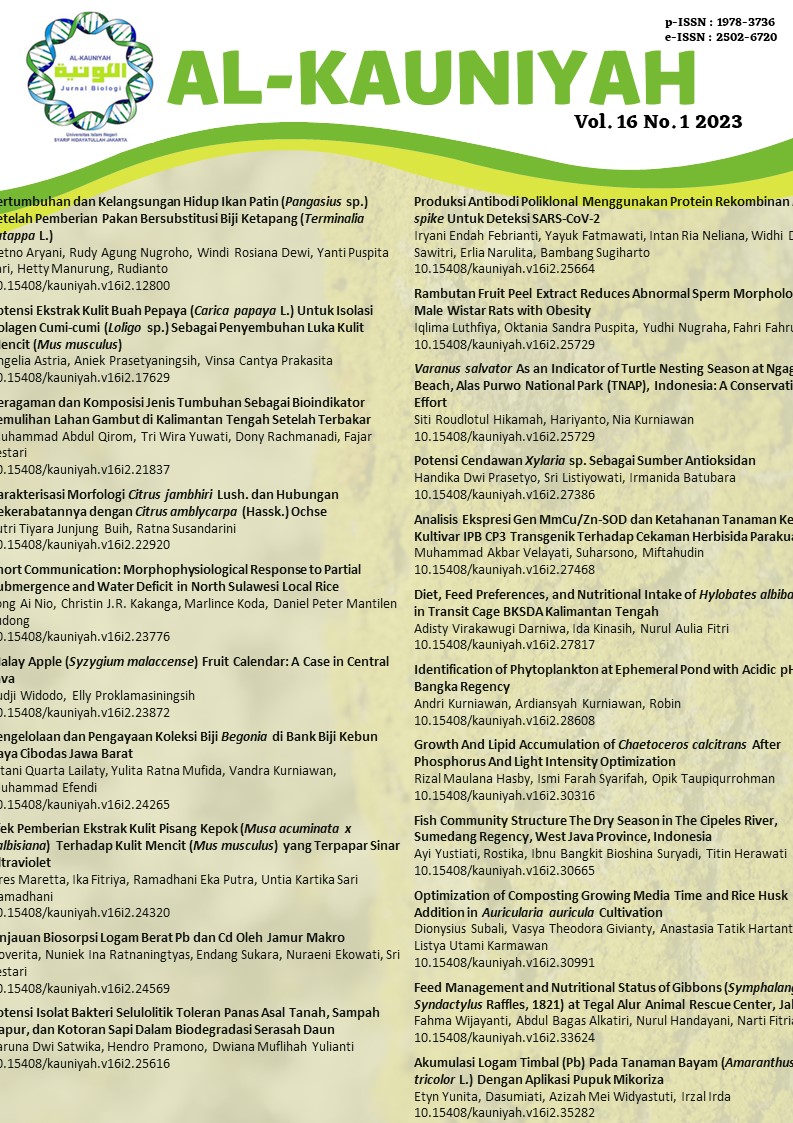Optimization of Composting Growing Media Time and Rice Husk Addition in Auricularia auricula Cultivation
DOI:
https://doi.org/10.15408/kauniyah.v16i2.30991Keywords:
Auricularia auricula, Biological efficiency, Composting, Mushroom cultivation, Rice husk, Budi daya jamur, Efisiensi biologi, Pengomposan, Sekam padiAbstract
Abstract
Auricularia auricula is a wood mushroom that is commonly consumed and is in demand by the people as a food ingredient because it contains many nutrients and health benefits. Cultivation of A. auricula was carried out using growing media and controlled environmental conditions. This study objective to determine the optimal combination of composting time and the rice husks addition in the A. auricula production. The treatment in this study was the composting time of the growing media for 0, 2, 4, 6, and 8 days, as well as the addition of rice husks as much as 0, 25, and 50%. This research consisted of the preparation of growing media, spawning and incubation of A. auricula, and harvesting of fruit bodies. The success of mushroom cultivation is seen from the value of biological efficiency in each treatment. The combination treatment of 8 days composting time with the addition of 50% rice husk resulted in A. auricula production as much as 52.37%, while the combination of 4 days composting time treatment and the addition of 25% rice husks resulted in the best production of A. auricula, as it produced the mushroom weight of 340 ± 16.95 g with biological efficiency value as much as 68% for five harvest durations within four months after first watering. The treatment of composting media tie and the addition of rice husks to A. auricularia’s were successfully carried out.
Abstrak
Auricularia auricula merupakan jamur kayu yang umum dikonsumsi dan diminati oleh masyarakat sebagai bahan pangan karena mengandung nutrisi dan banyak manfaat. Budi daya A. auricula dilakukan dengan menggunakan media tanam dalam kondisi lingkungan yang terkontrol. Penelitian ini bertujuan menentukan kombinasi perlakuan waktu pengomposan dan penambahan sekam padi yang optimum terhadap produksi A. auricula. Perlakuan pada penelitian ini adalah waktu pengomposan media tanam selama 0, 2, 4, 6, dan 8 hari, serta penambahan sekam padi sebanyak 0, 25, dan 50%. Penelitian ini tersusun atas pembuatan media tanam, pembibitan dan inkubasi A. auricula, dan pemanenan tubuh buah. Keberhasilan budi daya jamur dilihat dari nilai efisiensi biologi pada setiap perlakuan. Kombinasi perlakuan pengomposan 8 hari dengan penambahan sekam padi 50% menghasilkan produksi A. auricula sebesar 52,37%, sedangkan kombinasi perlakuan waktu pengomposan 4 hari dan penambahan sekam padi 25% menghasilkan produksi A. auricula terbaik karena menghasilkan berat jamur sebanyak 340 ± 16,95 g dengan nilai efisiensi biologi sebesar 68% selama lima durasi panen dengan waktu empat bulan setelah dilakukan penyiraman pertama. Secara keseluruhan, perlakuan waktu pengomposan media dan penambahan sekam padi pada media pertumbuhan A. auricula berhasil dilakukan.
References
Adebayo, E. A., & Carrera, D. M. (2015). Oyster mushrooms (Pleurotus) are useful for utilizing lignocellulosic biomass. African Journal of Biotechnology, 14(1), 52-67. doi: 10.5897/AJB2014.14249.
Apriliani, N. H., Syuhriatin, Fitasari, B. D., Swandayani, R. E. (2021). Pengaruh penambahan dedak padi terhadap pertumbuhan jamur tiram (Pleurotus ostreatus). Lombok Journal of Science, 3(3), 10-16.
Fermor, T. R., Smith, J. F., Spencer, D. M. (1979). The microflora of experimental mushroom compost. Journal of Horticultural Science, 54(2), 137-147. doi: 10.1080/00221589.1979.11514861.
General Horticulture Indonesia. (2020). Citing computer references. (2020, July 26). Retrieved from https://www.hortiindonesia.com/berita/budidaya-jamur-punya-potensi-ekspor-tinggi-permintaan-terus-meningkat.
Hadiyanti, N., Lisanty, N., Aji, S. B. (2020). Kajian produksi jamur kuping (Auricularia auriculajudae) pada berbagai komposisi media tanam, Jurnal Agroteknologi dan Agribisnis, 4(1), 1-43. doi: 10.30737/agrinika.v4i1.794.
Hartati, S., Sudarmonowati, E., Fatriasari, Q., Hermiati, E., Dwianto, W., Kaida, R., … Hayashi, T. (2010). Wood characteristic of superior sengon collection and prospect of wood properties improvement through genetic engineering. Indonesia Wood Research Journal. 1(2), 103-106. doi:10.51850/wrj.2010.1.2.103-107.
Hoa, H. T., Wang, C. L., Wang, C. H. (2015). The effects of different substrates on the growth, yield, and nutritional composition of two oyster mushrooms (Pleurotus ostreatus and Pleurotus cystidiosus). Mycobiology, 43(4), 423–434. doi: 10.5941/MYCO.2015.43.4.423.
Ingale, A., Ramteke, A. (2010). Studies on cultivation and biological efficiency of mushrooms grown on different agro-residues. Innovative Romanian Food Biotechnology, 6, 25-28.
Islam, T., Ganesan, K., & Xu, B. 2021. Insights into health-promoting effects of jew’s ear (Auricularia auricula-judae). Trends Food Science Technology. 144(2021), 552-569. doi: 10.1016/j.tifs.2021.06.017.
Kadnikova, I. A., Costa, R., Kalenik, T. K., Guruleva, O. N., & Yanguo, S. (2015). Chemical composition and nutritional value of the mushroom Auricularia auricula-judae. Journal of Food and Nutrition Research. 3(8), 478-482. doi: 10.12691/jfnr-3-8-1.
Kumla, J., Suwannarach, N., Sujarit, K., Penkhrue, W., Kakumyan, P., Jatuwong, K., Vadthanarat, S., & Lumyong, S. (2020). Cultivation of mushrooms and their lignocellulolytic enzyme production through the utilization of agro-industrial waste. Molecules, 25(12), 2811. doi: 10.3390/molecules25122811.
Liu, E., Ji, Y., Zhang, F., Liu, B,. Meng, X. (2021). Review on Auricularia auricula-judae as a functional food: growth, chemical composition, and biological activities. Journal of Agricultural and Food Chemical, 2021(69), 1739-1750. doi: 10.1021/acs.jafc.0c05934.
Rosnina, A. G., Wirda, Z., Aminullah, A. (2017). Efek penambahan sekam padi pada berbagai media tanam terhadap pertumbuhan dan hasil jamur tiram putih (Pleurotus ostreatus). Jurnal Agrium, 14(2), 18-25. doi: 10.29103/agrium.v14i2.876.
Statistics Indonesia. (2023). Citing computer references. (2023, March 1). Retrieved from https://www.bps.go.id/indicator/53/1498/1/luas-panen-produksi-dan-produktivitas-padi-menurut-provinsi.html.
Suprapti, S., & Djarwanto. (2013). Produktivitas jamur Auricularia spp. pada kompos serbuk gergaji kayu Falcataria mollucana. Jurnal Penelitian Hasil Hutan, 31(4), 271-282. doi: 10.20886/jphh.2013.31.4.271-282
Utoyo, N. (2010). Bertanam jamur kuping di lahan sempit. Jakarta: AgroMedia.

